MILITARY LAW
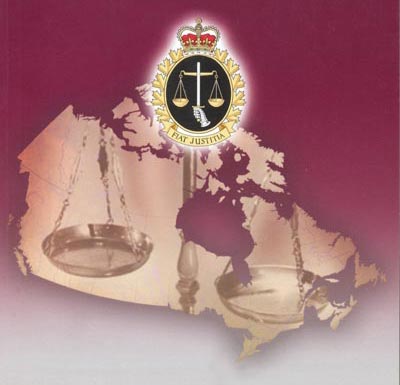
DND Photo
JAG Report Cover
The Many Problems in Military Personnel Law & Policy
by Rob Stokes
For more information on accessing this file, please visit our help page.
Major Rob Stokes, CD, BA., LLB., LLM., is a former infantry officer who now serves in the Office of the Judge Advocate General. He served for five years in the Directorate of Law, Military Personnel, advising on issues ranging from enrolment to release, and currently serves in the Directorate of Law, Compensation & Benefits. This paper does not necessarily reflect the views of the Judge Advocate General.
Introduction
Military personnel law and policy (MPLP) in the Canadian Forces (CF) has become a complex and often confusing topic. Superficially, there is a maze of innumerable and habitually inconsistent MPLP instruments: regulations, orders, instructions, manuals, etc. Yet there is even greater complexity and consequential confusion on its substantive level. It is time that this is confronted and discussed candidly.
This article advances toward three objectives. The first is to introduce a few of the different conceptual approaches to MPLP which often come into opposition with one another. Prominent in this introduction is the struggle between military instrumentalism and modern, liberal individualism. Differences between these approaches, and others, hinder MPLP coherence.
The second is to underline that MPLP’s core concepts—from enrolment through to release—are best viewed as a spectrum of closely related issues. On this spectrum, law is policy and policy is law. Because each different conceptual approach applies to most MPLP issues, it is a liability to view only a narrow band of the spectrum in isolation.
Third, this article makes a few observations on MPLP development. Substantive MPLP emerges from MPLP development. Any view of MPLP today would be incomplete without any exploration of some current realities in MPLP development. These observations are found under the heading “Development Hell.”
It is important to understand MPLP because all members have a personal stake in MPLP. Every member is enrolled in, serves in, and is eventually released from the CF. Many members administer MPLP daily to other members. Misunderstanding and misapplying MPLP affects members’ morale, finances, and careers. Poor MPLP wastes increasingly scarce CF resources. MPLP’s strategic implications are serious.
Today, there is MPLP confusion and complexity. Unapologetically, this article adopts a generally theoretical tone because: a) MPLP’s larger landscape is too often obscured by the dense undergrowth of MPLP specifics and trivialities; and b) when tackling conceptual challenges, nothing is more practical than theory. From that vantage point, this article concludes with a few suggestions on how MPLP may be improved.
Enrolment
Enrolment is usually seen as a process: paperwork, interviews, medicals, and so on. These sub-processes compose a part of enrolment. However, substantive matters lurk behind them.
First, assuming the CF is neither a public employment nor welfare project, but is an instrument to defend Canada, then the quintessential question is whether the CF can use the applicant. Every enrolment form, question, and examination aims to identify useful applicants. Those who appear to be useless should never be enrolled; their inefficiency will divert CF resources away from its instrumental purpose.
This question engages economics. By example, the CF undoubtedly can teach your parents to be CF-18 pilots; but can the CF do so efficiently? In an age of finite resources, the premium matching of one set of resources (instructors, money, time, etc.) to another (untrained people) justifies rigour in selection. Normative aspects of efficiency are also engaged; for example, why would the CF enrol someone who will be disruptive?

DND photo IS2011-6008-20 by Master Corporal Marc-André Gaudreault.
Seven CF-18 Hornets from 425 Tactical Fighter Squadron return to their home base, CFB Bagotville, 4 November 2011, after participation in Operation Mobile, the Canadian component of the NATO-led Operation Unified Protector effort against Libya.
Second, enrolment creates a legal condition—the liability to serve as a member until lawfully released. The modern, vexing concern is the nature of that condition.
Conventionally, military service constitutes a unilateral commitment, by the citizen to the Crown, in return for which the Crown assumes no obligations. In practical terms, a member can expect nothing from the Crown at any time, is obliged to serve the Crown at its whim, and can be released “at pleasure,” i.e. when the Crown wants. This concept’s origins are feudal, and its advantages strongly favour the Crown.
Recently, however, that view has been said to be out of touch with modern Canadian society. Public employment as feudal servitude is rejected. Public employment is to embrace a more contractual approach dictated, in whole or in part, by legislation. Furthermore, it is said that disputes over dismissal from public employment should, subject to legislation, be viewed through the lens of contract law. These recent developments seem amenable to modern CF life until the lens of contract is used elsewhere along the MPLP spectrum.
Contract clashes with unilateral commitment. Service without any expectation denies modern society’s expectation of benefit. If the two ideas could easily co-exist, then the precise point at which “at pleasure” ends and contract begins would be identifiable. But it is not. MPLP’s law might identify satisfactory answers but MPLP’s policy might not, and vice-versa. When law is policy and policy is law, such differences are problematic.
Attempting to reconcile such differences, there is normative talk of a Crown-member “social contract.” One code-phrase for this is that something is “the right thing to do.” The notion of a Crown-member social contract is revolutionary because it presupposes that: a) the Crown-member relationship is an ideological one; b) there is injustice within the relationship; and c) the extant relationship is somehow illegitimate. It furthermore ignores better alternatives, such as amending MPLP to reflect the “social contract” vision, or to stop talking about a “social contract” altogether.
Often obscured in the competition between these various approaches is their undisputed but crucial commonality: the subordinate servant must obey the superior master’s orders. That rule is the key to understanding the purpose of enrolment. Unfortunately, its instrumentalist essence is subjected to constant, individualistic forces.
Terms of Service
Terms of service (TOS) establish the length of the Crown-member relationship. Viewed through the lens of contract, TOS are easily understood: “The CF and I agree that I will serve for X period of time after which each of us can either freely walk away from the other or gladly renew our relationship.”
An immediate question is whether the agreement is symmetrically enforceable. The Crown has powerful enforcement tools: i.e., the offences of mutiny, desertion, insubordination, and disobedience of a lawful command. The CF member has only one tool: the right to release upon completion of TOS. Imbalances in negotiating power are common throughout society; therefore, whether TOS express “at pleasure” or contract is somewhat irrelevant. But irrelevance does not prevent resentment that there is an imbalance from which to begin.
TOS also have structure. Legislation permits the CF to use two types of TOS: fixed and indefinite. Fixed TOS create a legal right to release at a pre-determined point in time. Indefinite TOS lack this effect but are administratively more convenient. A current MPLP debate asks whether fixed TOS provide any administrative benefit, especially after de-linking TOS from pension entitlement.
One’s position in that debate usually follows one’s assessment of: a) CF benevolence, particularly the CF’s policy of allowing nearly every member to release on six months notice; and b) the importance of protecting individual legal rights. Yet, benevolence and rights should never be confused.
Perhaps because of a practical compromise in that argument and previous pension legislation, the CF has long used a hybrid TOS structure in the Regular Force. The first several TOS tend to be fixed; an indefinite one is offered after long service.
The length of the initial TOS (and periods of “obligatory service” after education) often expresses an economic principle: the CF wants a return on the CF’s investment. However, after the initial investment is recouped, the principle motivating the diversity of fixed TOS between various occupations is unclear. Occupation-specific TOS arguments are undermined by the CF’s benevolent, six month voluntary release policy. Moreover, although there is efficiency in offering a single, common, pan-CF TOS after every initial fixed TOS, MPLP does not offer it.
Indefinite TOS are different than fixed TOS. First, “indefinite” conveys temporal uncertainty, facilitating termination at any time, i.e. “at pleasure.” Nonetheless, a current MPLP phenomena equates indefinite TOS to service until retirement age. This turns indefinite TOS into very long fixed TOS. The phenomena are explicable only if one links individual dignity to job security; but employee job security is not typically an employer’s instrumentalist choice.
Second, there is MPLP controversy over when to offer a member indefinite TOS. Some suggest when the member has obviously chosen the CF as a career; but how is that assessed? Some contend when the member is proximate to the right to release by reason of an annuity; but what is the benefit of any TOS beyond that point? Some urge an early offer of indefinite TOS to entice a member to chose the CF as a career; but this puts the burden of a CF-slanted agreement, and the absence of a tangibly foreseeable right to release, upon the shoulders of a person with little or no CF experience.
Concerning Reservists, they can serve on fixed TOS, but invariably, are only offered indefinite TOS. This is an MPLP choice; perhaps TOS enforcement cannot be reasonably reconciled with fundamentally part-time service in a volunteer force. Alternatively, economics may have led the CF to forego the administrative costs of managing fixed TOS. This suggests some incoherence in the Total Force concept, which will be discussed later.
To these observations are added two others. First, MPLP perhaps teaches bad citizenship: the CF’s six months notice policy condones members’ broken promises. Short fixed TOS might address this problem, but many members may view them as failing to provide long-term employment security.
Second, MPLP ignores the option of members’ serving without any TOS after they complete their fixed TOS. Nothing requires the CF to release a member whose fixed TOS have expired and who has not claimed their release. In times of severe attrition, every extra day of service extracted from a member helps the CF. A strict instrumentalist MPLP approach would retain CF assets for as long as they are useful.

DND photo ET2011-6049-02 by Corporal Brandon O'Connell.
Machine gun training while on patrol in the Mediterranean Sea
Components
At enrolment (becoming a member), the choice of component, and sub-component, determines when the member is available (at the Crown’s service) to be ordered to do any assigned job (to perform duty).
There may be three components: the Special Force, the Regular Force, and the Reserve Force. The last has four sub-components: the Primary Reserve, the Cadet Organizations Administration and Training Service (COATS), the Canadian Rangers, and the Supplementary Reserve. Each component and sub-component engenders a unique service obligation. Legislation establishes three types of service obligations:
- “Continuing full-time military service.” The Regular Force is on this type of service. Its members are always available for duty - even at 2 a.m. on a Sunday morning.
- “Other than continuing full-time military service when not on active service.” This is particular to the Reserves. The phrase “other than continuing” means that service in this component is fundamentally part-time in nature.
- “Active service.” It is suggested that this is best defined by what it does. Active service engenders “continuing full-time military service.” It imposes additional legal restrictions and obligations upon the member that are, by legislation, deemed necessary for CF efficiency when it is in its operational mode.
These three distinct obligations reflect the CF’s original design. The Special Force was to be a full-time component used in wartime, as war was envisioned immediately after the Second World War. The Regular Force was to be a full-time component in peacetime, its members being the professional seed of the Special Force. The Reserve Force was for wartime mobilization. In peacetime, Reservists were only needed part of the time—for training and sundry domestic duties. These overarching concepts have spawned considerable controversy.
Total Force
The Total Force concept expresses a degree of integration between the Regular Force and the Reserve Force. The concept exists in tension with the CF’s original, post-Second World War legislative design whose premises were: a) members of the two components are different in commitment, character, background, and training; and b) any synthesis should occur in a common, third component—a wartime Special Force. From the 1950s onward, the constant, active service status of the Regular Force contributed to the marginalization, and, finally, the irrelevance of the Special Force. The original, legislative design was forgotten, and the Regular Force and Reserve Force were left to bicker over its remains.
There are several approaches to the controversy. The economic and sociological approaches are the most common. The former might argue for the allocation of resources on the basis of optimal benefit. The Crown’s finite resources should be given to something it can always use (a full-time member) instead of something it can only infrequently use (a part-time member). This approach also explains many differences in pay and benefits. A sociological approach might concentrate on group dynamics and class relations. Because the CF is composed of all its members, distinctions between sub-groups of members (components) should be reduced, if not eliminated. Pay and benefit equality arguments follow. With modification, both approaches are used by advocates on each side of the Total Force controversy.
There is another approach that is invariably overlooked. The controversy might be better informed by acknowledging the consequences of the Special Force’s absence. Can the CF presume that a government will never constitute the Special Force? No. Consequently, some consideration should be given to how the CF should organize itself to prepare for that event. Today’s Total Force ideal of two integrated components occurs within—and against—the legislative design for three distinct ones. The controversy should encompass that fact.
Component Transfers
Component (and sub-component) transfers are related to the Total Force controversy. Transfers change a member’s service availability. The member who was available full-time is now available only part-time, and vice versa.
The original legislative design strongly implies that full-time to part-time transfers should proceed as though they were releases. The reverse (part-time to full-time) is, however, dissimilar to enrolment. Therefore, the design hastens increases in service liabilities, and slows decreases in service liabilities. It is purposively biased in favour of preserving full-time service in either the Special or Regular Force.
The governing view in modern MPLP displaces that bias and favours a ‘faster-is-better’ approach that satisfies members who want a seamless career, gracefully transferring between components. Individualism dominates, but it is unclear why it should dominate. From an instrumentalist perspective, a speedy decrease in service liabilities can hurt the CF: member satisfaction does not assure CF operational effectiveness. Furthermore, the seamless career reduces administrative predictability and diminishes the meaning of service in both components. Moreover, there is no empirical evidence that a substantial number of members actually avail themselves of the seamless career.
Component transfer MPLP also exhibits schizophrenia. Consider Reserve Force to Regular Force transfers. MPLP law allows a transfer to take 30 seconds to complete. However, MPLP policy sees administrative hurdles: i.e., credentials are scrutinized, and the Reserve Force sergeant is reverted to Regular Force corporal.
Given the original design’s Special Force, and the ongoing imperative to anticipate emergencies, it can be provisionally accepted that a sergeant in one component should be able to do the comparable job in another component somewhat efficiently, or at least adequately. If the sergeant cannot, then the original design has tools, such as reversion and re-muster, to position the member correctly in the new component. Therefore, it is unclear why MPLP is fixated upon pre-transfer administration; perhaps bureaucratic formalism defeats both instrumentalist and individualistic interests.
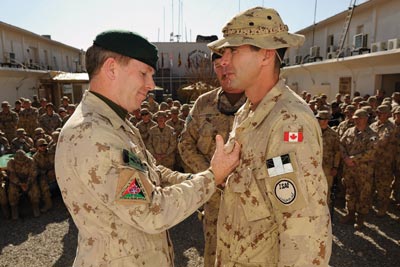
DND photo AT2011-TO35-09 by Master Corporal Chris Ward.
Promotion made during a general’s visit to Camp Alamo in Kabul, Afghanistan
Membership, Service, and Duty
Earlier, this article associated “member” with legal status, “service” with availability, and “duty” with the obligation to perform assigned jobs. The legal position of the Regular Force is straightforward: every member is always available to do any assigned job. The member’s duty to do an assigned job, at any time, is correlative to the CF’s right to assign a job, at any time. The concepts operate together coherently.
Their operation in the Reserve Force is different. Active service aside, Reservists are liable to serve only in accordance with regulations; only then is the correlative in effect. Regulations parse different Reservists’ liabilities. At one extreme, members in the Primary Reserve may be ordered to train for a specific number of days, or be called out to do duty (not called out to train). At the other extreme, those in the Supplementary Reserve must serve only when placed on active service by reason of an emergency. Daily Reserve Force routine then produces conceptual challenges. Consider three cases:
First, absent a training order, how does the Reservist come to be on duty on a Tuesday night at the armoury? Typically, Reservists make themselves available for service by leaving home, going to their unit, and signing in. At that moment, it appears that the Reservist is on duty. Suppose, however, that the unit is not conducting any training, or does not want that particular member to train: is the member on duty or even on service? Can the member unilaterally put themselves on service or on duty, or is some agreement with the Crown required? If the latter, who makes that agreement on behalf of the Crown? These questions pit contractual consent against “at pleasure” commitment.
Second, what is a “Class ‘A’ Reservist”? This term is perplexing. MPLP law permits a Reservist to be on Class A Reserve Service one day, Class B the next day, and Class C the day after. Each type of Reserve Service expresses: 1) the duty performed; and 2) when it is performed. There are no Classes of Reservists. MPLP policy, however, welds the service type to specific establishment positions, and microscopically manages establishment movements. Consequently, the CF loses administrative dexterity. It is unclear why a technocratic choice is allowed to handcuff instrumentalist objectives.
Last, what is a “Class ‘B’ contract”? The ubiquitous belief in the mini-contract must be explained as a sub-set of either a larger Crown-member contract, or of the “at pleasure,” unilateral commitment. The inherent contradiction of mini-contracts in a larger “at pleasure” context fractures MPLP consistency. The contradiction diminishes only if the mini-contract either: a) exists within a larger contractual framework; or b) is not viewed as a contract at all. Yet, both alternatives disrupt the status quo belief.
Military Occupations
The essential questions are these: a) does a person enrol in the CF, or in a particular occupation in the CF; and b) in either case, what is the scope of the liability to perform any lawful, military duty?
The first question has always been difficult. Historically, regiments were very occupation-specific, and involuntary transfers between regiments were highly objectionable. The 1960s’ MPLP sketch recommended general service for nearly all officers (hence “general service officer”) and occupation-specific service for all other ranks (“trades”). Although this theoretically partially reduced the basis for objections, nearly all involuntary transfers, in practice, remained objectionable.
Objections today often pit managerial discretion against enrolment-inducing statements. For example, a member complains that a pre-enrolment promise to be trained in a particular occupation has been broken by a post-enrolment occupation transfer. On the one hand, the member made a life-altering choice in relying upon the recruiting centre’s representations with respect to the first occupation. On the other hand, the CF needs someone in the second occupation, and this particular member is available for service. These competing views illustrate the larger conceptual struggle: what is the nature of enrolment?
The scope of liability presents equal difficulty. When on service, members are liable to perform any lawful military duty. The legality of ordering a trained infantry corporal to attack an enemy position is clear. Much harder is ordering that same corporal to do the job of a pay clerk but without the necessary training. Mistakes and errors are foreseeable. Presumably, the CF—an instrumentalist body—wants to mitigate those risks. Therefore, a lawful order might also imply a reasonable order, given the member’s experience, skill, and training.
Assuming the same, is a member’s duty liability somehow wedded to their specific occupation? If ‘yes,’ then job security is engaged, and “at pleasure” service is somewhat diminished. If ‘no,’ then reasonableness should control, and the CF may be obliged to train members so that its orders to them may be objectively reasonable. Either way, MPLP struggles to explain how the member has made a unilateral commitment, in return for which the Crown assumes no obligations.

DND photo ET2011-6031-01 by Corporal Brandon O'Connell.
Air surveillance operations off the coast of Libya
Authority
The question “what will the member do?” is definitely asked once a person becomes a CF member who is liable to perform duty when on service. The member’s occupation provides an incomplete answer. Legislation, orders, and instructions must also be considered, as well as discretionary MPLP relations and devices: i.e., “superior officer,” promotions, reversions, seniority, command, postings, appointments, and occupation assignment and transfers. It is a challenge to view these disparate elements coherently, but all are part of some MPLP whole.
The concept of authority offers one lens. Every government body asks itself whether the legislature granted it the authority to do X in manner Y under Z circumstances. MPLP can adopt this as follows: is this particular member intended to exercise this particular authority in this particular manner in this particular location? The affirmative justifies the member’s present circumstances. The negative instigates postings, promotions, release, and other administrative action.
Authority is also contextual. That a colonel has more authority than a captain is a rebuttable, contextual presumption. Authority may contextually turn on expertise: the captain doctor is a better authority on surgery than the infantry colonel. It may turn on position: the corporal sentry denies the unknown colonel entry to a secure area. Authority is also encompassing: i.e., 1) the untrained private’s lack of authority; 2) the legislative authority to report a superior who contravenes the Code of Service Discipline; and 3) the deprivation of authority because of incompetence, inefficiency, or misconduct.
The key difficulty for MPLP is that the concept of authority is polarizing. An instrumentalist embraces it, but the individualist rejects it, or wishes to constrain it. One important question is whether a member has a right, an enforceable claim, to hold an authority that is theoretically to be granted solely at the CF’s discretion.
The subject of promotion is illustrative: does a member have a right to be promoted? MPLP permits approval of a promotion if there is a vacancy on the CF establishment, and a member who meets certain conditions and standards is recommended for promotion. Evaluation reports and merit boards are tools in the approval process. Together, they construct promotion as a privilege granted at the CF’s discretion. Consider, however, uncontrolled promotions from private to corporal, or from lieutenant to captain. There is also promotion upon enrolment (or after graduation from training) for doctors, lawyers, military police, and others. In such instances, active CF discretion is minimized to the point that the member believes in a claim-right against the CF to assist the member in obtaining the promotion. Perception matters: “I should have been promoted” is a common grievance.
If the concept of authority is the best lens, and if claim-right can impinge upon it, then the scope and legitimacy of the ‘master-servant relationship’ created at enrolment are jeopardized. A privilege-grant and a claim-right are irreconcilable. Whether the CF intended a member to have a particular authority becomes irrelevant when the member can claim that particular authority. This imperils the nature of service to the Crown.
Today’s MPLP de jure position is contested by MPLP’s de facto recognition of members’ authority interests. Service to the Crown is distorted: the binary, hierarchical construct mutates into some form of a participatory, social dynamic more typical of a union, a self-governed profession, or a guild. The classic mantra “To the Queen” confronts a contemporary Canadian question: “What about me?”
Release
“What about me?” is the individualist’s seminal question in release matters. Release may be viewed from at least three vantage points: a) service terminated “at pleasure;” b) the expulsion from a self-regulated profession; and c) the termination of a contractual relationship. MPLP today mixes these perspectives in surprising ways. In doing so, it blurs the CF’s character and impairs the CF’s ability to manage itself.
The self-regulated analogy sees members posted to positions where they are authorised to approve another member’s release; CF culture and norms are brought to the approval process and exert a degree of self-regulation. In contradiction, the CF’s design explicitly calls for an undemocratic CDS control and administration. That the Governor-in-Council appoints the CDS theoretically weakens the self-regulatory model because the Chief of the Defence Staff: a) is not necessarily the product of a widely-held CF culture; and b) is empowered to change that culture. There is embedded tension in this model.
The contractual model does not fit perfectly, either. It is true that the termination of private and CF employment can be reduced to a few comparable reasons: a) the person cannot do the job; b) the person does not want to do the job; c) the organization does not want the person to do the job; and d) the organization no longer has a job for the person to do.
Nonetheless, there are also differences. For instance, “specific performance”—forcing the person to work—distinguishes CF from civilian employment. A civilian employee has a (nearly) absolute right to walk off the job, but military legislation (i.e., the offence of desertion) prevents a member from doing the same. Contract also implies contractual rights: does a CF member have an enforceable right to CF employment? The standard answer is ‘no;’ all members supposedly serve “at pleasure,” and the Crown can unilaterally release its servants from service. Two phenomena, however, temper this answer: 1) the CF invariably releases members only on the basis of some fact, not some whim; and 2) the CF overly uses procedural fairness, a hall-mark of job security. Both phenomena hint at a fettered managerial power.
Release MPLP today alternates in its use of these three different perspectives. For example, the enrolment offer of a good steady job with a prospect of a pension makes it difficult to deny the member’s taste of contract. But members who believe their release was unjustified grimly learn that they have no contractual remedy. There is an understandable degree of confusion.
Compounding it is the team social dynamic. Because of the adverse consequences of a loss of employment, some members who regulate the CF as a profession may hesitate before expelling another, unsuitable member. Release decision-makers are members as well. The presence of union-like thinking—and union solidarity—in CF membership should not be under-estimated. Self-regulation allows conflict of interest, and struggles to serve the public interest and a member’s interest concurrently. The same is said of many other self-regulating professions.
Once upon a time, release MPLP asked blunt questions: a) what can the member do for the CF? and b) does the CF want the member? To use these questions in their most ruthless form for the sake of instrumentalist efficiency might require a significant societal change, perhaps one beyond the CF’s grasp. But MPLP has failed to identify any coherent alternative to them. If the CF is a seriously instrumentalist body, then it would not want alternatives. It would rather seek fair—not necessarily procedurally fair—ways to keep asking the blunt questions.
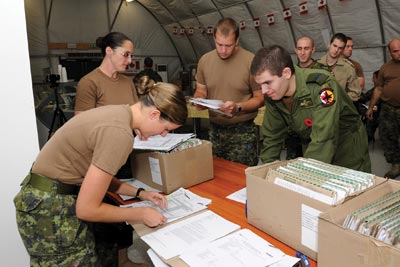
DND photo ET2011-6031-01 by Corporal Brandon O'Connell.
Members of the Sicily Air Wing conduct out clearance
Development Hell
Aggravating MPLP’s conceptual difficulties are several practical difficulties. These belong under the rubric “development hell,” a place where ideas are still-born, or bitterly attacked and procedurally suffocated. A few of MPLP’s practical difficulties are described below.
MPLP conception and expression require the expenditure of finite intellectual capital. That capital is also in demand elsewhere in the CF. An inability to expend that capital risks producing poorly conceived MPLP, epitomised by the uninspiring “… we must do something, this is something, let’s do this.” Such an abdication can result in a tendency to issue only minor MPLP clarifications and amendments. Consequently, individual strands of MPLP tend to feed off one another: MPLP X creates a perceived need for exception Y, whose unexpected consequences lead to nuance Z. The MPLP field becomes crowded and mangled. MPLP becomes a wilderness of single instances.
When a conceptual field is fallow, inadequate substitutes can move in. For instance, an existing, seemingly non-controversial order may be blandly converted into a new format and trumpeted as progress—but that is not new, innovative MPLP. Another example sees practice replacing concept: i.e., a clerical attitude saying that MPLP concept X cannot work, because MPLP practice Y is used today.
MPLP development also contends with the strong CF desire for consensus. ‘Push-down’ MPLP initiatives might quickly overcome the consensus-imperative if they lack specificity. ‘Push-up’ initiatives confront numerous obstacles, including the need for further horizontal consensus as the initiative progresses vertically. Compounding this is a recurring need to educate, because the MPLP developers’ reasoning and motivation become increasingly diluted, the more distant the staffing location of the initiative from those developers. Achieving and maintaining consensus is exhausting.
Once achieved, consensus remains fragile, horizontally and vertically, until MPLP publication. One dissenting voice in a consensus-driven environment can thwart months or years of studious work. Bargaining—especially across vertical hierarchies—also imperils consensus. Bargaining can even involve issues unrelated to the MPLP initiative. The epitome of this phenomenon in this author’s experience involves a pan-CF conduct policy being held hostage to a senior heckler’s demand for an extra clerk: no extra clerk, no policy endorsement.
There is a more insidious threat to MPLP development: CF members have ideological biases. Some members are, for example, instrumentalists and some espouse individualism. Every opportunity to participate in MPLP development is an opportunity to inject a particular ideological slant to an MPLP concept. These threats can spring from anywhere and anyone.
There are several filters to identify the type of ideologue with whom one is dealing. One is procedural fairness. If Canadian law requires that MPLP use procedural fairness when taking administrative action against a member, then both the instrumentalist and individualist will agree that it must be used. If, however, Canadian law does not require procedural fairness, then, generally, the instrumentalist will oppose using procedural fairness, and the individualist will advocate its use. Similarly, the normative member will urge “the right thing,” but the economist will advise adopting the most economically efficient (not necessarily the cheapest) option. The key point is that all members in MPLP positions use their ideologies to shape or attempt to shape policy; MPLP development is a political exercise.
In light of the aforementioned difficulties, it is not surprising to see fatigue and exhaustion in MPLP development. The expenditure of intellectual capital in an already busy day, clearing the MPLP wilderness here and there and everywhere, avoiding polarising controversy, overtly or subtly fighting for one’s ideology in any initiative, building and maintaining—or torpedoing—consensus, bargaining with other MPLP participants, and outwitting the hecklers: combined, these are daunting challenges for any member working in MPLP development. They are especially daunting for MPLP amateurs on a short posting. It is far easier to coast in passive tranquility to the end of one’s posting. Bland activity substitutes for actual accomplishment. Unfortunately, there is a risk this is becoming an acceptable MPLP norm.
These and other, similar features of “development hell” allow MPLP to slowly drift into a state of confusion and complexity. That state is not an enviable one.
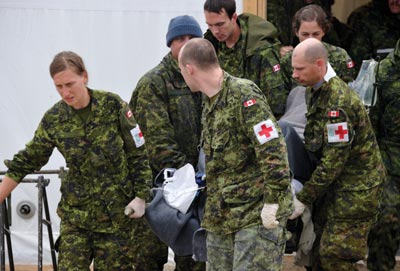
DND photo ET2011-6031-01 by Corporal Brandon O'Connell.
CF medical members carry one of the three survivors of the First Air plane crash at Resolute Bay, Nunavut
What is to be done?
There are many things that can be done to reduce MPLP’s confusion and complexity. Four are believed to be decisive: 1) recognize the MPLP context; 2) build MPLP expertise; 3) measure MPLP development; and 4) impose upon all MPLP one single ideological bias.
The chain of command paradigm is not the dominant one in MPLP. Some chaotic mutation of a Westminster democracy prevails. In the CF there are: fractious political parties, wayward cabinet ministers, unruly backbenchers, special interest groups, devious lobbyists, loud picketers, militant unionists, supposedly non-partisan judges, unexpected court rulings, finicky constituents, and elections—i.e. postings—every few years. All influence MPLP development.
The analogy is apt, because many MPLP issues are socially normative. This distances MPLP from many operational matters (which are philosophically more comparable to scientific positivism and sovereign command theory). The analogy also demands realism in one’s expectations of senior CF leadership. To seek clear-cut direction from the senior MPLP chain of command is to reveal naivety. There is a partial, legitimate excuse for their silence or inaction: they cannot take an MPLP view from nowhere, even though that is sometimes exactly where they begin.
They could be better informed by experts. Across all government departments, sophisticated policy development is recognized as a professional skill. Generally, the CF lacks that skill-set for MPLP. Readily imaginable arguments in favour of using amateurs are, it is submitted, flimsy and unconvincing. The CF could benefit from permanent MPLP expertise, combining a mature appreciation of: 1) military administrative history; 2) public policy development as a skill and as an art; and 3) principles of administrative law. Located near the apex of the CF hierarchy, a small group of somewhat senior but very ‘service-savvy’ MPLP professionals with a remit to develop and write pan-CF MPLP of strategic importance but tactical application—from enrolment to release—might reduce MPLP confusion and complexity, and assist MPLP leaders in expressing their vision.
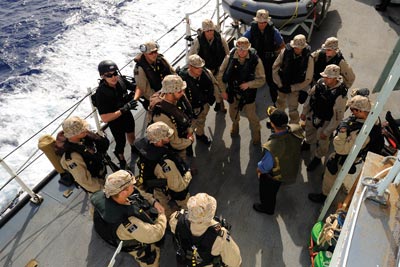
DND photo ET2011-6026-03 by Corporal Brandon O'Connell.
HMCS Vancouver CO speaks to the boarding party prior to their departure to search a Vessel of Interest
Developing that expression cannot continue ad infinitum. Activity is, in fact, a lousy substitute for actual accomplishment. Yet, the development of many MPLP initiatives drones on endlessly. The CF should adopt a temporal benchmark for every MPLP initiative. From the moment CF senior leadership determines—with or without lower level prompting— that it needs sound MPLP about subject X, the CF should be able to produce it in a timely manner. Much of CF unification and integration went from concept to reality in less than five years. The United States of America’s participation in the Second World War lasted less than four years. Given the immense scale of those undertakings, it is suggested that one year is a reasonable target for expert MPLP staff to produce sound MPLP on even the most difficult of MPLP subjects.
But something more is probably needed.
The MPLP framework the CF uses today was written in 1950. It evolved in the mid-1960s. It has remained largely unchanged since then. Few CF members have any mature recollection of the 1950s and 1960s. But the CF and its members have changed. Conceptual tension is the modern framework’s currency. Social integration, the radiating effect of constitutional values, egalitarianism, contract, individualism, legal economics, instrumentalism, collectivism, the “social contract,” public service equivalency, feudalism (“at pleasure”), and other discernable philosophies, notions, and trends competing for prominence in MPLP today: all brew together, but few blend well.
I suggest that there are two primary antagonists in today’ MPLP: a) instrumentalism; and b) individualism. (True, economics is an omnipresent variable but it perhaps only informs choices made under the others). Instrumentalism is the CF’s imperative: everything is a tool to defend Canada, and to fight and win wars. Individualism is a societal fact: the individual is of primary importance. This article speaks principally to the conclusion that MPLP is now constantly experiencing the struggle between instrumentalism and individualism. Neither is in apparent control; neither ever surrenders. At stake is the CF’s strategically vital terrain of MPLP conception, development, and implementation. The prolongation of this contest is not in the CF’s best interest.
MPLP coherence demands monism and consistency. Monism looks to one single principle, a master principle informing everyone and everything. Consistency is the regular application of the master principle in the expression of rules. MPLP’s rules—law as policy and policy as law—are now undergoing an unenviable dynamic: a fragmentation into a chaotic collection of petty rules lacking a coherent whole. This is unsustainable and increasingly unmanageable. Complexity and confusion threaten.
What is to be done? The CF must from necessity choose between two incompatible, conceptual alternatives: instrumentalism or individualism. One might temper the other—but only one can dominate. A clear, decisive choice that expresses and imposes the desired ideological bias across the CF would go a long way toward resolving the many problems in modern MPLP.

DND photo GD2011-0887-13 by Corporal Laura Brophy.
Aircraft Technician from 14 Wing Greenwood is greeted by his loved one after arriving home from Operation Mobile






